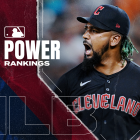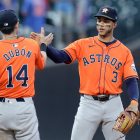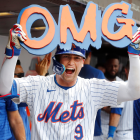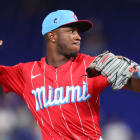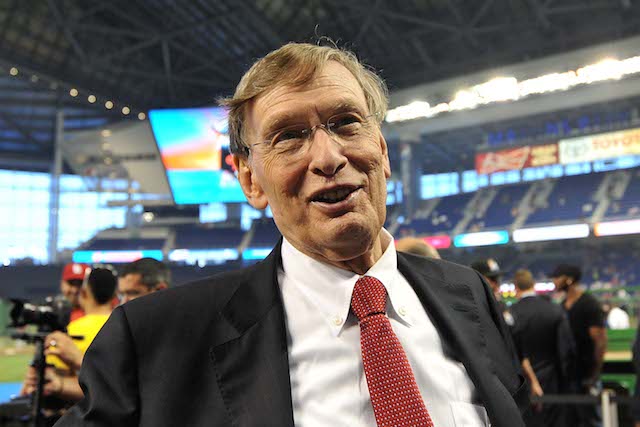
1994 Strike: What if Expos won? | Other hopefuls | Individual chances at history
The strike of 1994 was a lacerating event for anyone who cares about baseball. We lost the World Series. We were deprived of seeing Tony Gwynn, Matt Williams and maybe Ken Griffey Jr. take on the forces of history. We didn't get to see just how far the Montreal Expos could go. The litany goes on and on. Twenty years hence, though, who should we blame for what happened to baseball in the summer of '94?
Many of us tend go with the tidy and lazy "pox on both their houses" approach, seeing no sense in distinguishing between the millionaires and billionaires who afflicted the game. A great many also blame the players. There's perhaps some anti-unionism baked into this, and there's also the quaint notion that ballplayers, because they get paid to play a game, should be happy with the riches they have. The former is a topic for another forum, and the latter is just envy dressed up in populism. In reality, it's the owners who should wear the labor stoppage of 1994 as a shame of their own making.
In a sense, it began in late 1992, when the owners, mere months after ousting erstwhile commissioner -- and labor realist -- Fay Vincent, voted to re-open the 1990 basic agreement (MLB's collective bargaining agreement with the MLBPA) for negotiation a full year before it was set to expire. This would allow the owners to press for their favored changes, and this -- along with whispers of a possible lockout before the 1993 season -- was the shot across the bow.
What many owners wanted was increased revenue sharing, but the only way they could build a consensus was to promise the anti-revenue sharing block of owners that they, as a collective, would push for a salary cap. Outwardly, the owners advanced concerns about competitive balance (never mind that baseball's competitive balance "problems" in the free-agency era have been illusory), but they were also fretting over an ill-advised national television contract.
Also, there's an "arrow of causality" question here. An alternative theory posits that the owners settled on a desire for a cap first but that small-market owners blanched at the idea of their large-market peers pocketing all that overage. That's where the revenue sharing groundswell may have come in -- as a way to ameliorate those owners who, say, didn't want to see the Yankees clearing the kind of profits they would clear under a capped system. In either case, the desire for greater profits -- not a desire for increased competitive balance -- was the driver.
In either case, the owners were asking the players to give back some of their hard-won freedoms because the owners weren't able to unify. Ponder that line of thinking for a moment.
Furthermore, and as I've pointed out before, salary caps do nothing to promote competitive balance -- they're simply vehicles to depress labor costs. As presented to the public, they're a ruse, and only a "valet to ownership" kind of union accepts them (looking at you in particular, NFLPA.)
So the union rightly feared that if the players didn't strike, then the owners would simply declare an impasse and install the economic structure of their fondest dreams. The owners' first step toward doing this was, upon re-opening negotiations, to ... not negotiate at all. Indeed, the owners didn't even make a formal proposal to the players until 18 months after they re-opened negotiations.
Here are some of the proposed changes they finally conjured up:
• Hard salary cap to be phased in over four years;
• No more salary arbitration;
• Somewhat accelerated free agency timetable, but free agent's current team to have right of first refusal (i.e., right to match other offers and retain player);
• Players' share of revenues to be reduced from 56 percent to 50 percent;
• Player pensions and health benefits to come out of players' half of revenues;
• Players' licensing revenues to be split with owners.
This 18-month rollout set the tenor of things, and this was the anti-free market system players were faced with if they didn't strike. No union worth its name would accept this kind of retrograde system absent genuine crisis. Needless to say, the MLBPA shot down the owners' proposal with haste and offered up a largely "status quo" one of their own.
At that point, the owners opted not to make a scheduled pension payment even though they were required to do so. Given the players' pre-existing mistrust of the owners thanks to the collusion scandal less than 10 years prior, this further poisoned the relationship.
The strike dragged on, lawmakers found themselves drawn to the blaze, mediators mediated, the owners forced out their lead negotiator, but the sides remained entrenched. Finally, the players propsed a luxury tax system -- softer by degrees than the one we have now but still similar in structure. This was an important capitulation by then-MLBPA head Don Fehr because it was something his pioneering predecessor, Marvin Miller, would never have abided. Yet it wasn't the hard cap the owners craved, so it didn't lead to any breakthroughs. Sure enough, the owners implemented their system after the 1994 season was truncated.
So the appeals and legal wrangling began. It didn't go well for the owners. The National Labor Relations Board ruled that the owners didn't bargain in good faith, and soon thereafter a US District Court issued an injunction against, yes, the owners.
Eventually, a new basic agreement was forged, one with increased revenue sharing and a steeper luxury tax than the one the players initially proposed, but not before the business end of the '94 season was lost. There was -- and thankfully still is -- no salary cap. Since '94, we've had a long run of labor peace after enduring eight labor stoppages between 1972 and 1994.
Looking back, there's irony, or at least grim coincidence, in that the owners' disingenuous push for competitive balance cost the small-market Montreal Expos their best shot at a championship. That's the owners' legacy in all of this -- the sickening, whether cynically or indifferently, of that which they purportedly wanted to cure.
So, by all means, place the blame for the baseball pyre of 1994 where it belongs: upon the owners.









